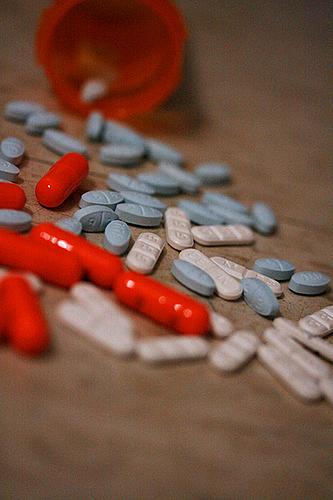Top Prescribers: How One Doctor Made Medi-Cal's Psychiatric Drug List

How does a doctor become a top prescriber of a psychiatric drug in one state’s Medicaid program?
Dr. Steven Balt, a Bay area psychiatrist and the editor-in-chief of the Carlat Psychiatry Report, had to ask himself this question recently after a tweet he sent elicited a revelation that more than 1,000 prescriptions for Seroquel had been billed to Medi-Cal – the California Medicaid program – under his name in just one year. Seroquel is an antipsychotic drug approved to treat schizophrenia and other severe psychiatric disorders. The drug has been at the center of two big controversies for its maker, AstraZeneca. In 2010, the company agreed to pay $520 million to settle a federal investigation into its marketing of Seroquel. And in 2011, the company settled more than 28,000 lawsuits against it for allegedly misleading patients about the drug’s side effects, which include significant weight gain and diabetes.
As Antidote has written about before, Sen. Charles Grassley and the U.S. Senate Finance Committee have been investigating problems with overprescribing psychiatric drugs, painkillers and other drugs. As a result, Grassley has gathered records on a range of prescription drug-related issues.
Recently, bloggers have started posting some of those documents and commenting on them, including the self-described “mental health watchdog” Citizens Commission on Human Rights. The Commission was founded by the Church of Scientology, known for its anti-psychiatric drug stance. When a document containing lists of the top prescribers of name-brand psychiatric drugs in California from 2009 to 2011 was posted on PsychSearch.net, Balt saw that one of his former colleagues at an Oakland mental health clinic was on the list of top prescribers for 2011. So last week, he sent out a sarcastic tweet.
That turned out to be a pot-kettle-black moment.
Another writer, Stephany at Soulful Sepulcher, sent him a tweet saying, “is page 7 you, or someone else? 2009 1000+ rx of Seroquel?”
Balt told me in an email that he was stunned.
How did I become the No. 4 Seroquel prescriber in 2009, with over 1,000 prescriptions to my name?
So, how did he? First, Balt says he thinks the number is misleading because it is easy to assume that 1,000 prescriptions means 1,000 new patients were put on Seroquel. In reality, he says, most of these prescriptions likely were refills. He wrote me:
More than 1,000 new prescriptions in one year is hard to fathom. Given my part-time schedule there, it would have meant six to seven new prescriptions each day, which is impossible. However, if it includes each month's refills for patients who took the drug all year long, that does not seem at all unreasonable for that clinic. Given the volume of patients (and their specific requests for Seroquel, a medication in high demand), automatic refills were frequently given.
In a May 2010 letter to Grassley releasing some of the top prescriber documentation, the chief of California’s Pharmacy Benefits Division, Pilar Williams, makes a similar point:
We share your interest in protecting the Medicaid program from fraud, waste and abuse, and in that spirit are providing you with the information in the format you have requested. We caution, however, against the potential for misuse or misinterpretation of this information if used independently and without regard for the multitude of factors that should be considered.
Still, Balt acknowledges that he prescribed more Seroquel when he first started working than he did in subsequent years and than he does now. He says the clinic’s environment encouraged a reliance on prescriptions – versus looking for other ways to address a patient’s behavioral or psychiatric issues. He wrote me:
That was my first full year at a clinic where quick visits, busy schedules, and knee-jerk prescribing were the order of the day. Over time, I became quite disappointed -- if not angry -- at what seemed to pass for "treatment" and the overwhelming emphasis (on the part of patients and doctors alike) on the use of psychotropics to manage what were, most of the time, sociocultural stressors in our largely indigent, population. On several occasions I approached the executive director and medical director about the quality of care we were providing and about the influence of drug reps on prescribing habits, but no changes were ever made.
I asked him how many of those 1,000 prescriptions he would estimate were for the actual indication of schizophrenia? He wrote:
I'd estimate that 50% to 70% were for "schizophrenia." Keep in mind, however, that a schizophrenia diagnosis is freely given in these settings, e.g., for otherwise healthy people who say, "I talk to myself sometimes," or "I sometimes see shadows at night," or "I'm always looking behind my back when I'm outside," etc. As for the rest, those prescriptions were probably given for bipolar disorder or off-label for sleep. As I learned more about the metabolic effects of Seroquel I tried to use less of it.
Balt’s name does drop off the top prescribers list in 2010 and in 2011. He says that’s for a reason.
I have worked at other clinics, and my experience tells me that overprescribing is rampant in the Medicaid setting and apparently accepted as the standard of care. I have seen the same over-reliance on psychotropics, over-diagnosis and waste of resources in other parts of the state, although the volumes were not nearly as high as what I experienced in Oakland.
Balt didn’t leave the clinic until early 2012. So why did he stay at a clinic where he was concerned about the quality of the care? A big part of the reason is that Balt was on probation with the Medical Board of California at the time. We’ll talk about that later in the week.
Image by Amanda M. Hatfield via Flickr
